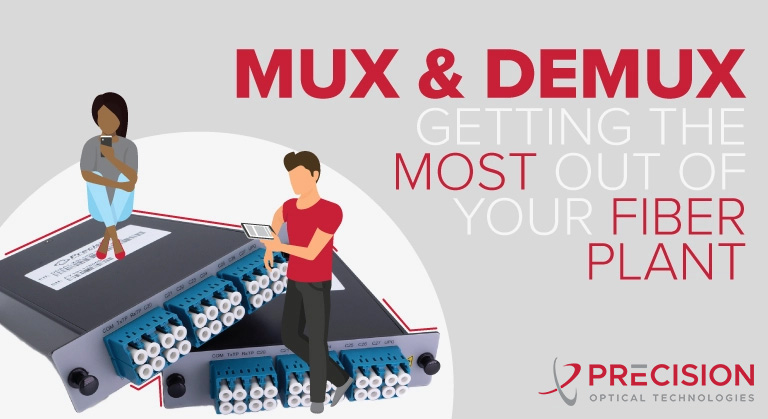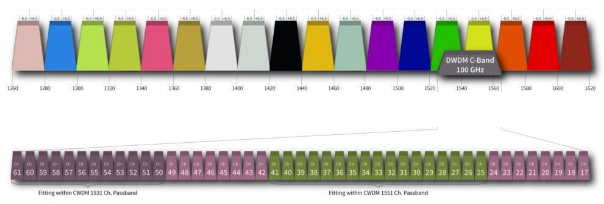
MUX/DEMUX: Getting the Most Out of Your Fiber Plant

In WDM: Everything You Need to Know we talked about the types of Wavelength Division Multiplexing(WDM) used in optical networks and in what situations CWDM or DWDM work best. In this blog, we’ll cover how WDM is implemented in MUX/DEMUX (Multiplexing/Demultiplexing) modules and the many benefits these systems provide in a network. While MUX/DEMUX technologies historically were used for long-haul and subsea carrying purposes, they have more recently been making their way closer to subscribers to leverage the untapped fiber spectrum. MSO networks are using MUX/DEMUX systems to scale network capacity and get the most out of existing fiber.
MUX/DEMUX Technology and Benefits
Advances in WDM technologies include improvements in optical components, increased channel counts, enhanced spectral efficiency, and higher data rates. These advancements have made MUX/DEMUX more accessible, reliable, and capable of supporting higher capacity networks. Optical networking has seen significant growth in the use of MUX/DEMUX systems in recent years. According to Omdia, the 400G WDM market alone has “witnessed a year-on-year increase of 55%, with 400G WDM becoming the go-to for operators in network construction.” It’s no wonder, when MUX/DEMUX offers so many advantages:
- Increased Transmission Capacity: MUX/DEMUX enables multiple wavelengths (channels) to be transmitted simultaneously over a single optical fiber, dramatically increasing the capacity of the fiber optic network.
- Cost Efficiency: Instead of deploying new fibers for each service or wavelength, MUX/DEMUX enables network operators to multiplex several services onto a single fiber, reducing the need for new fiber installations. This is especially beneficial in situations where fiber deployment is sparce, particularly challenging or expensive.
- Simplified Network Architecture: MUX/DEMUX simplifies network architecture by reducing the number of jumpers and complex point-to-point connections required. This simplification improves network management, scalability and reduces operational complexities and cost.
- Scalability and Flexibility: MUX/DEMUX offers flexibility and scalability by allowing network operators to add or remove wavelengths or services without disrupting the overall network infrastructure. This flexibility enables the network to adapt to changing bandwidth demands and easily accommodate future network expansions.
MUX/DEMUX Applications: High Capacity and Channel Selection with OADMs
MUX/DEMUX systems find widespread use in many telecommunications network applications including long-haul systems, metro networks, data center interconnects (DCI), FTTx deployments and network protection and restoration schemes.
Long-haul, Core and Metro applications were historically the first to benefit, where MUX/DEMUX systems have long been used to efficiently transmit large volumes of data traffic vast distances, connecting cities, regions or even countries. More recently, MUX/DEMUX usage has expanded to Access Networks to address the growing demand for bandwidth while minimizing the need for additional fiber infrastructure. DWDM MUX/DEMUX deployments are often favored as they offer scalable multi-channel solutions, commonly supporting 40 to 48 wavelengths on a single fiber with 100GHz spacing.
In the network types mentioned above, a special type of MUX/DEMUX called an Optical Add-Drop Multiplexers (OADMs) are utilized for the selective addition or removal of specific wavelengths at intermediate points along the fiber route. OADMs can add an additional wavelength to the existing multiplexed signal allowing for insertion of new data streams or the expansion of network capacity. Conversely, they can selectively drop certain wavelengths enabling the extraction of individual data streams at intermediate points in the network, thereby routing data to specific destinations or network nodes. This adding or removal of wavelengths as needed is done without disruption to the overall network, allowing dynamic network reconfiguration to accommodate changing traffic patterns, service demands or network maintenance requirements.
Similarly, the channel monitoring capabilities of OADMs allow network operators to keep tabs on power levels and signal quality of transmitted wavelengths. In the event of a fiber breakage or equipment failure, OADMs provide the ability to reroute affected wavelengths to alternate paths or backup fibers. This proactive measure helps address issues that may affect signal quality or network performance, ensuring continuous service availability and minimizing downtime.
MUX/DEMUX: How Precision OT can help
MUX/DEMUX systems can provide increased network capacity, efficient utilization of fiber resources, scalability, simplified network management and cost savings. While MUX/DEMUX modules are amazingly powerful and beneficial to your network, implementing these devices is not as simple as buying a product off the shelf and installing it. Check out this article written by one of our Solutions Engineers to better understand system-level network considerations and “how customization and support are key to avoiding costly misadventures.” Whereas some companies offer only set wavelength/channel plans, we’re able to go beyond and offer the specific channels needed as well as specific monitoring, test or other ports as needed.
Precision OT specializes in leveraging our MUX/DEMUX products and advanced systems engineering experience to significantly enhance the workload capacity of your fiber network. Our experts are proficient in everything from effectively communicating intricate requirements to overseas vendors, to delivering cost-effective turn-key network solutions. For all of your CWDM, DWDM and dual fiber duplex Mux/Demux needs, contact Precision OT!







